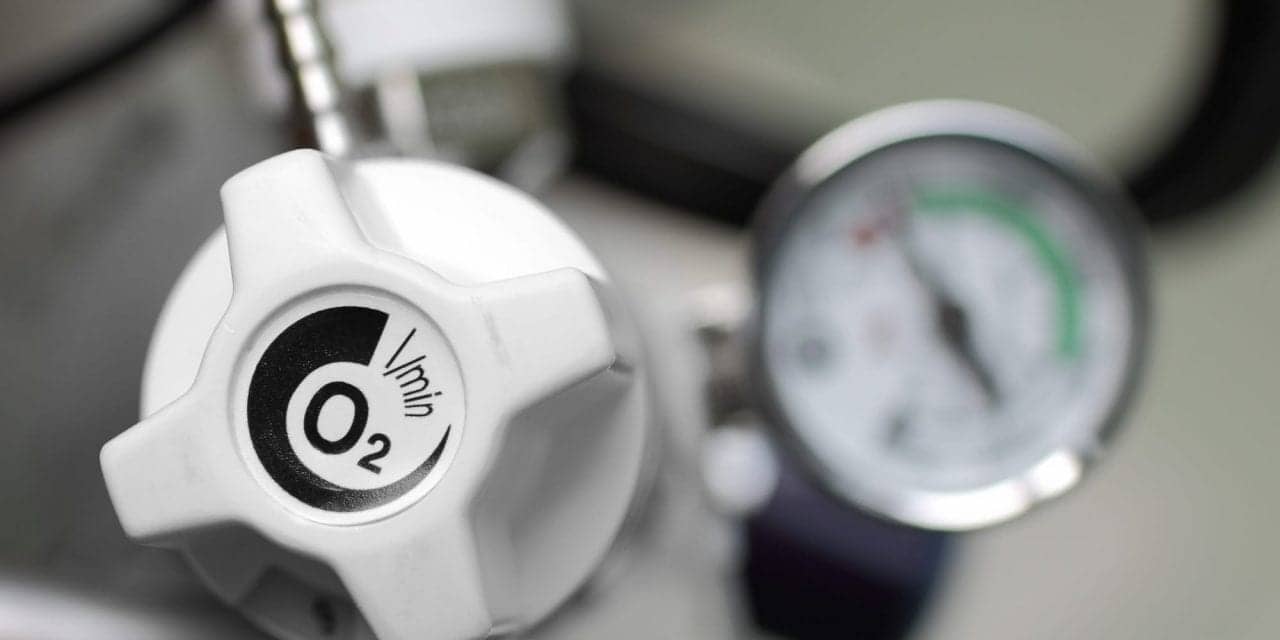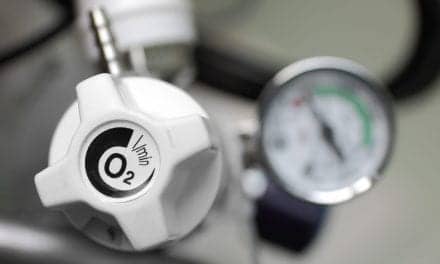Based on clinical evidence, the utilization of high flow oxygen (HFO) therapy via high-flow nasal cannula (HFNC) in appropriate patients can improve oxygenation, decrease the patient’s work of breathing, and serve as an alternative to more invasive forms of treatment, such as mechanical ventilation.
By Kenneth Miller, MEd, RRT-ACCS, RRT-NPS, AE-C
Improving gas exchange and decreasing work of breathing are clinical end-points when managing patients with respiratory compromise. Oxygen administration has been one of the most common interventions used over the past several decades. Almost every patient admitted to an emergency department or intensive care unit is placed on some form of oxygen administration. Often the choices are to provide oxygen via a mask, or a more aggressive form of clinical management, such as noninvasive ventilation (NIV) or mechanical ventilation.

However, a high-flow oxygen (HFO) therapy system can deliver a high-flow air/oxygen blend through a nasal cannula or tracheal adapter, providing an alternative to other forms of ventilation. By providing flow rates of up to 60 LPM, high molecular humidity, and precise oxygen delivery, HFO may reduce the need for noninvasive ventilation and intubation in selected patient populations.
Historically, oxygen delivery devices have been labeled as either low-flow or high-flow, based on design application. Each of these systems has inherent advantages and liabilities when compared to each other. Low-flow systems often are more comfortable, but the ability to deliver a precise oxygen concentration in various respiratory breathing patterns is limited.
A high-flow system can deliver very accurate oxygen concentrations, but is often uncomfortable and obtrusive.[1] Recently, an oxygen delivery device has been developed that can deliver precise oxygen concentrations at various flow rates and provide a level of comfort to the patient.[2] It also can deliver positive end-expiratory pressure (PEEP) that may splint conducting airways or recruit collapsed alveoli.[3] Since it utilizes a molecular humidification system, it can increase humidity delivery and promote mucokinesis, thus helping to prevent mucous plugging.[4] HFO increases patient comfort during oxygen administration and may allow some patients who are NIV dependent to eat or receive nursing care without potential life-threatening desaturation.
HFO consists of a heated, humidified high-flow nasal cannula (HFNC) that can deliver up to 100% heated and humidified oxygen at a maximum flow of 60 LPM via nasal prongs or cannula. An air/oxygen blender can provide precise oxygen delivery independent of the patient’s inspiratory flow demands. Based on different bench and patient models, positive end-expiratory pressure may be generated. In these models, for approximately every 10 liters of flow delivered, about 1 cm/H2O of positive pressure is obtained.
On the Market
A key element for clinical use of nasal oxygen at high flows is its effective humidification.[5] The first two commercial adult HFNC systems designed to deliver flows with accompanying humidifiers appeared in 2000, manufactured by Salter Labs and Vapotherm.[6]
Today, Salter offers the Adult High Flow Cannula 1600HF, which allows effective delivery of oxygen flows up to 15 LPM, according to the company.[7] The device, designed for long-term wear, features a larger bore safety channel head set tubing with an enhanced reservoir face piece.[7]
Meanwhile, Vapotherm’s 2000i High Flow Therapy (HFT) system allows high flow gases to be delivered via nasal cannula while warming and saturating the gas stream.[8] The 2000i uses a nasopharynx as the gas reservoir, which prevents the inspiratory gas from being diluted by remaining end-expiratory gas, according to the company.[8] The device delivers a flow range up to 40 LPM with 95% to 100% relative humidity and a temperature range of 33° to 43°C (~91° to 109°F), without cooling or drying the airway.[8]
In addition, Vapotherm now offers its Precision Flow high flow heat and humidification device for noninvasive gas delivery. Like the 2000i, Precision Flow offers a flow range of 1 to 40 LPM.[8] The device, which features a disposable patient circuit, provides clinicians with precise temperature and flow measurements and is equipped with a built-in oxygen blender and oxygen sensor. The Precision Flow’s delivery tube is designed with air surrounded by two water-filled channels and allows molecular water vapor to pass into the gas stream, but without contact between water source and breathing gas, according to Vapotherm.[8]
Teleflex offers High Flow Nasal Cannula Therapy through its Comfort Flo Humidification System. The system is designed to provide continuous flow of heated, humidified oxygen therapy to neonate patients through adult patients, according to Teleflex.[9] Comfort Flo works with the company’s ConchaTherm Neptune heated humidifier to deliver flow rates up to 40 LPM through a line of specialty nasal cannulas.[9] Clinicians are able to monitor and adjust airway temperature and gradient control in order to customize HFO therapy.[9]
The Optiflow High Flow Nasal Cannula by Fisher & Paykel began clinical use in 2006.[6] The Optiflow cannula is designed with a wide bore in order to deliver a complete range of gas flows up to 60 LPM. Optiflow was designed with Fisher & Paykel’s concept of Optimal Humidity in mind, which allows high flow oxygen and gas to be delivered comfortably directly into the nostrils.[10] Optimal Humidity reflects what F&P calls “the natural balance of temperature and humidity that occurs in healthy adult lungs.”[10] This optimal temperature (37°C/98.6°F) and humidity (44 mg/L) improve patient tolerance and optimize mucociliary clearance, according to Fisher & Paykel.[10]
The system integrates heated humidification and precision air/oxygen blend via nasal cannula.[10] While humidification improves patient tolerance and airway secretion clearance, the high gas flow “drives accurate delivery of oxygen, washout of anatomical deadspace, and provision of low level positive airway pressure.”[10]
According to Fisher & Paykel, the effectiveness of HFO therapy using HFNC may lead to improved oxygenation in patients combined with fewer desaturations, improved lung volumes, improved respiratory rates, reduced ICU length of stay, and reduced treatment cost.[10]
Clinical Application
High-flow oxygen delivery has been clinically utilized in a wide spectrum of patient care arenas. It has been administered to patient populations in critical care units, emergency departments, and end-of-life scenarios, and recently has migrated into the home care environment. In the adult critical care population, there have been several studies that have demonstrated positive outcomes, post-HFO utilization.
In a 2013 study of high-flow oxygen via HFNC devices for adult and perinatal patients, Ward concluded that HFO had the following therapeutic effects:[6]
- Increased fraction of inspired oxygen (FiO2)
- Gas inlet flow prevents secondary room-air entrainment;
- Provides anatomic oxygen reservoirs using nasopharynx and oropharynx;
- Washing out of airway dead space;
- Development of a CPAP effect
- Decreases atelectasis;
- Improvement in pulmonary ventilation-perfusion;
- Decreases work of breathing: counteracts intrinsic PEEP;
- Greater patient comfort
- Warmed and humidified nasal oxygen can be better tolerated, especially with flows >6 LPM.[6]
Roca et al compared HFNC with conventional oxygen therapy via a mask in 20 critical care patients and demonstrated that HFNC via Optiflow was better tolerated and more comfortable than an oxygen mask.[11] HFNC also was associated with an improvement in oxygenation and a reduction in respiratory rate.[11]
Kernick and Magarey compiled a systematic review that examined eight studies comparing oxygen therapy with HFNC in adult ICU patients. The study demonstrated that HFNC may be used to improve oxygenation in adult critical care patients.[12]
In a randomized crossover of 50 mechanically ventilated patients deemed suitable for ventilator liberation, Tiruvoipati et al demonstrated that HFNC was as effective in providing oxygenation as a conventional oxygen system and was better tolerated by patients. In addition, six case studies on adult critical care patients demonstrated improved oxygenation and a reduction of respiratory rate or dyspnea.[13]
Lenglet et al examined the utilization of HFO in the emergency department for patients with acute respiratory insufficiency who may benefit from noninvasive ventilation. In addition to the ability to generate high flow and concentration of supplemental oxygen, HFNC generates a low level of positive airway pressure, especially with the mouth closed.[14] In hypoxemic patients, HFNC may provide effective support with greater ease of use and patient comfort than techniques requiring a tight face mask.[14]
High-flow oxygen administration also has been utilized in the end-of-life clinical arena. In a recent study conducted by Peters et al, it was demonstrated that patients who would have been treated via NIV were successfully maintained with HFO.[15] NIV is typically initiated in the ICU setting, so that it is common for a patient with do-not-resuscitate (DNR) or do-not-intubate (DNI) status to be admitted or transferred to the ICU specifically for consideration of NIV. This study sought to identify DNI patients with hypoxemic respiratory failure who might benefit from HFNC before proceeding to NIV.[15] The objective of the study was to assess the effectiveness of HFNC in DNI patients with hypoxemia and mild hypercapnia, the need for escalation to NIV, parameters of ventilation and gas exchange, and patient tolerance. The outcome of this study showed that humidified HFNC oxygen therapy can provide adequate oxygenation for many patients with hypoxemic respiratory failure, and may be an alternative to NIV for patients who decline intubation.[15]
Currently at Lehigh Valley Hospital Network, our respiratory care department equipment inventory has 20 HFO systems. In calendar year 2012, we utilized HFO on 510 patients.[16] The majority of these patients receive HFNC in the critical care units. HFO via tracheotomy adapter was applied to 25 patients. Patients in whom oxygenation goals were maintained via HFO spent 7.2 days less in the ICU than patients who needed escalation of therapy (mechanical ventilation or NIV).[16] The majority of patients who were placed on HFO were placed on it for oxygenation end-point. A small number were administered HFO to combat increased work of breathing and to enhance secretion removal.[15]
Conclusion
High-flow oxygen therapy allows the clinician to provide accurate oxygen delivery in a wide array of patient populations and treatment arenas. It is a treatment intervention that all respiratory care clinicians should have in their therapy arsenal when treating patients with mild to moderate hypoxemia. Based on the clinical evidence, the utilization of HFO therapy in appropriate patients can improve oxygenation and can decrease the patient’s work of breathing without the need for noninvasive or invasive ventilation. In addition, it may reduce the duration of ICU stay in some patients. Larger clinical studies need to be conducted to determine its full impact on patient outcomes.
RT
Kenneth Miller, MEd, RRT-ACCS, RRT-NPS, AE-C, is the educational coordinator and dean of wellness, respiratory care services, for Lehigh Valley Health Network in Allentown, Pa. For further information, contact [email protected].
References
- Wettstein RB, Shelledy DC, Peters JI. Delivered oxygen concentrations using low-flow and high-flow nasal cannulas. Respir Care. 2005;50(5):604-609.
- Chanques G, Constantin JM, Sauter M J, et al. Discomfort associated with underhumidified high-flow oxygen therapy in critically ill patients. Intensive Care Med. 2009;35(6):996-1003.
- Parke R, McGuinness S, Eccleston M. Nasal high-flow therapy delivers low level positive airway pressure. Br J Anaesth. 2009;103(6):886-90.
- Parke RL, McGuinness SP, Eccleston ML. A preliminary randomized controlled trial to assess effectiveness of nasal high-flow oxygen in intensive care patients. Respir Care. 2011;56(3):265-270.
- Waugh JB, Granger WM. An evaluation of 2 new devices for nasal high-flow gas therapy. Respir Care. 2004;49(8):902-906.
- Ward J. High-flow oxygen administration by nasal cannula for adult and perinatal patients. Respir Care. 2013;58(1):98-122.
- Salter Labs. http://www.salterlabs.com.
- Vapotherm Inc. http://www.vtherm.com.
- Teleflex Inc. http://www.teleflex.com.
- Fisher & Paykel Healthcare Ltd. http://www.fphcare.com.
- Roca O, Riera J, Torres F, Masclans JR. High-flow oxygen therapy in acute respiratory failure. Respir Care. 2010;55(4):408-413.
- Kernick J, Magarey J. What is the evidence for the use of high flow nasal cannula oxygen in adult patients admitted to critical care units? A systematic review. Aust Crit Care. 2010;23(2):53-70.
- Tiruvoipati R, Lewis D, Haji K, Botha J. High-flow nasal oxygen vs high-flow face mask: a randomized crossover trial in extubated patients. J Crit Care. 2010;25(9):463-468.
- Lenglet H, Sztrymf B, Leroy C, Brun P, Dreyfuss D, Ricard JD. Humidified high flow nasal oxygen during respiratory failure in the emergency department: feasibility and efficacy. Respir Care. 2012;57(11):1873-8.
- Peter S, Holets S, Gay P. High-flow nasal cannula therapy in do-not-intubate patients with hypoxemic respiratory distress Respir Care. 2013;58(4):597-600.
- Miller K, Horoski D, Leshko R. A six month review of high flow oxygen delivery system outcomes. Abstract in press.










